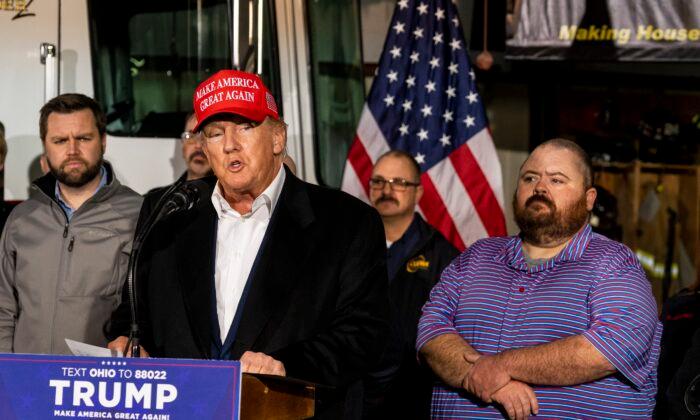Former President Donald Trump and his 2024 presidential campaign, released his “America First” trade plan that would promote universal tariffs on most imported goods if he takes office for his second term.
His revised trade policy would “tax China to build up America,” and focus on rewarding domestic production while imposing tariffs on imported goods.
Trump Offers New Tariff Deal to Punish Beijing
Since leaving the White House in 2021, Trump has been highly critical of President Joe Biden, who he accuses of punishing domestic producers. while rewarding multinational outsourcers and hostile nations like communist China.
“Biden’s pro-China economic program puts America last and it’s killing our country,” Trump said.
“My cutting-edge trade agenda will revitalize our economy by once again putting America first. We will quickly become a manufacturing powerhouse like the world has never seen before.”
Trump said he plans on completely eliminating American dependence on China by stripping it of its most favored nation trade status, adopt a four-year plan to phase out all Chinese imports of essential goods, and ban federal contracts for any company that does outsourcing to Beijing.The United States’ trade deficit with China has risen almost 10 percent under Biden to $382.9 billion in 2022 alone, while American money and jobs are being exported to the communist state.
The White House intends on implementing the tax policy during the worse inflation crisis in decades, which has already hurt millions of American families nationwide.
Universal Baseline Tariff Would Fill US Treasury’s Coffers, Says Trump
Trump said if he were in charge, he would instead impose a universal baseline tariff on foreign producers of most imported goods, rather than raise taxes on American producers.
He said that he would gradually increase tariffs if other countries manipulate their currency or otherwise engage in unfair trading practices, like China.
The former president believes that if tariffs on foreign exporters go up, domestic taxes on American workers, families, and businesses would decrease substantially.
“That means a lot of jobs coming in,” the 45th president said.Trump said higher tariffs will “increase incrementally depending on how much individual foreign countries devalue their currency.”
He slammed the practice of other countries devaluing their currency, while subsidizing their industries, saying they were engaging in what he described as “trade cheating and abuse.”
He noted that they still “do it now like never before,” but that his administration had largely stopped it “and it was going to be stopped completely within less than a year” if he stayed in office, according to Trump.
“As tariffs on foreign producers go up, taxes on American producers will go down, and go down very substantially.”
45th President to Continue His Administration’s Trade Policy
Trump called his new economic plan the “linchpin of a new Strategic National Manufacturing Initiative, that builds on my historic success in ending NAFTA.”He called his replacement of the North American Free Trade Agreement (NAFTA) one of the most “tremendous” achievements of his administration.
After negotiating with the leaders of Mexico and Canada, Trump replaced the NAFTA accords with the United States-Mexico-Canada Agreement (USMCA), which covered more than $1.3 trillion of commerce throughout North America.
The USMCA required that 75 percent of automobile components be manufactured in the United States, Canada, or Mexico in order to avoid tariffs.
The new trade agreement required that 40 to 45 percent of automobile parts be made by workers who earned at least $16 an hour by 2023.
The USMCA was expected to create thousands of new jobs tied in the auto industry in North America and bring in around $30 billion of new investments into the sector.
In addition, the trade deal was designed to open up new markets for American agricultural products like wheat, poultry and eggs.
“We’re also going to end other unfair trade deals, and we'll end them quickly,” added Trump.
For example, the former president scrapped the Obama administration’s agreement to participate in the Trans-Pacific Partnership trade agreement in January 2017.
This deal was created to further trade ties between the U.S. and eleven other countries around the Pacific.
The remaining countries negotiated a new trade agreement called the Comprehensive and Progressive Agreement for Trans-Pacific Partnership, which incorporates most of the provisions of the TPP and entered into force in December 2018.





